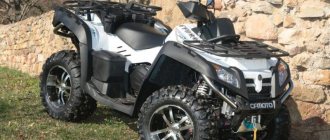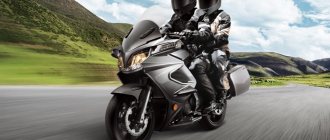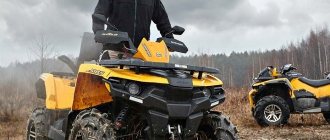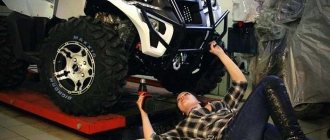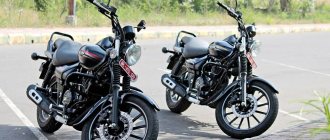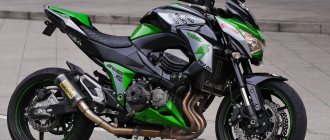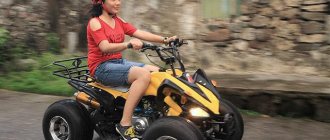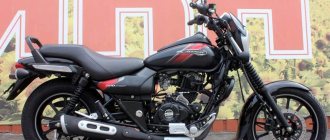The X8, also known as the Terralander, is a feature-packed quad with an 800cc V-twin engine. see. At the moment, the only thing missing is power steering. CF Moto have always focused on price, with the X8 selling for a great price at launch.
Specifications
Well, let's go through the long list of characteristics. Let's start with the engine: a four-valve V-twin with a liquid cooling module and a considerable power of 46 kW. It is important that it produces 72 Nm of torque. Impressive numbers for 800cc engines, regardless of manufacturer.
Everything is simpler with the transmission: low, high, reverse and neutral gears. Set it to rear-wheel drive or all-wheel drive, and if necessary, you can turn on the differential lock. All switches are conveniently located on the handles. The drive switches with just the press of a button.
From the driver's seat, the X8 feels compact, and compared to the rest of CFMoto's lineup, it's hard to tell the size difference. However, the X8 has a comfortable seat for two and a larger backrest, plus some handy grab handles.
The LCD instrument panel shows many parameters: speed, revolutions, fuel level and time. There is also a full set of warning lights and an activated drive indicator. A few words about fuel: the X8's gas tank holds 23 liters.
The suspension has also been stiffened to match the increased power. CFMoto used DNM shock absorbers; independent suspension. A nice innovation is aluminum control levers. Hydraulic brakes front and rear: front discs with a diameter of 220 mm, 150 mm at the rear. disk.
Another interesting detail: the X8 can tow up to 450 kg and comes with a tow hook as standard. Also included is a 1360 kg winch. (3000 lbs); indicators and lights are built-in. And a 12 V socket adds to the already impressive list of features.
CF800-X8 EFI: Inside
And again the quad arrived dusty. I should immediately note that its configuration is slightly different from the standard one. Firstly, a STORM aluminum skid plate is installed. Secondly, the air filter housing has been modified. Previously, I ran in the tested equipment without any design changes, but since it is possible to drive quietly at best only for the first hundred kilometers, it is better to protect the most vulnerable places. Read about other modifications I made during the CF800-X8 EFI test in the corresponding section of the site.
I checked the available threaded connections - and, lo and behold, this time I couldn’t tighten anything (apparently the factory pays increased attention to the careful assembly of the new model). Even the wheels are screwed on properly - with sufficient torque, but not overtightened. The pressure in all is 0.2 atm (especially for me or something). However, the pre-sale test failed again and again due to small fasteners. Only this time it was not under-tightened, but simply lying on the step: I found a nut, but apparently it did not come from this ATV, the Chinese probably lost it during assembly (during pre-sale they could have at least noticed it and removed it).
At the request of those who like to ride in slippers and shorts, the variator body is covered with a plastic heat-reflecting screen (apparently this is one of the super modifications for Russian conditions). It looks nice, but an ATV is far from a bicycle to ride without the appropriate equipment, and especially to places where you usually ride in shorts and a T-shirt.
The main brake cylinder is dual-circuit. One circuit acts on the rear brake, the second on the front calipers (the brake cylinders in them are double, with separate cavities, connected independently to both the GTZ and the brake handle on the steering wheel). The brake fluid reservoir is located above the GTZ and is accessible from the wheel arch without removing the trim. Since the parking brake on the X8 directly locks the transmission, two holes in the caliper mounting plate are free.
And again, the first thing you pay attention to is the protective arches. Are they really metal, or are they just a Chinese plastic imitation? Yes, it is metal, moreover, it is stainless steel! True, I still don’t understand, wasn’t there a better place for reflectors? In the end, it was easier to provide a corrugated reflective section on the rear lights than to weld a stainless steel corner on the jamb.
Both radiators (water and oil) are of a new design (different from the CF500 and X6) and, most importantly, are spaced at a greater distance than the X6, which will both somewhat reduce the likelihood of debris clogging between the heat exchangers and will facilitate the work of flushing them from mud. The fan switch sensor is covered with an additional cover. The outlet pipe of the cooling system is also protected by an additional shell. The expansion tank is located in the right wheel arch (let me remind you that its neck is accessible when the “hood” is opened).
There are somehow fewer mudguards than on younger models, but the exhaust tract is insulated inside and out, and with rather thick-walled aluminum ducts. Here, as they say, it’s better to see once:
What can only be appreciated live is the sound of the exhaust. In the case of CFMOTO's 800cc V2, it's simply ROCK'N'ROLL! The difference in sound compared to a single-cylinder engine, even of a similar volume, is approximately comparable to the difference in the exhaust of a 4-cylinder engine from a V8 - in absolute terms, “only” one cylinder has been added, but in relative terms their number has doubled! The muffler, fortunately, was designed specifically for this model (and not like on the X6 from 500). The overall sound picture is spoiled and darkened by the well-known knock “from the variator”, reminiscent of the clanking of the transmission shaft of the LiAZ-677 bus (I think most readers still remember these buses and are even nostalgic for them). For the X8, the factory considers this normal, although in essence it is, of course, abnormal and here’s why. That "variator" sound isn't actually a CVT sound at all. It comes from the crankshaft, which has axial (transverse) play and during operation “dangles” left and right. In this case, the main liners (on which the crankshaft rests) are pressed directly into the silumin of the thin halves of the power unit housing. The transverse movement of the crankshaft leads to the fact that it begins to chip off the soft alloy at the points of contact with the halves; the chips worsen the already weak supply of oil to the narrow liners, which are not only forced to work in a plane unusual for them (the crankshaft “rides” along them to the left). to the right), they also overheat due to insufficient oil pressure, resulting in scoring. As a result, everything quite quickly ends with them (the inserts) turning. Why it was not possible to make the crankshaft on bearings (like the same V2 from Arctic Cat) - I don’t know. Apparently the Chinese from CFMOTO wanted to prove that they can do anything, including making V2 on earbuds themselves. There is nothing to say about the survivability of the motor when the quad is drowned - on bearings you can, without any special consequences, if you don’t get home, then at least get out of the swamp even on an emulsion; on liners, a similar action will immediately lead to the death of the motor.
The cardan shafts have no play in the crosspieces, but the drive shafts are similar to those installed on the younger CFMOTO models, as well as the axle gearboxes. Are you wary? Me too, but according to the factory and the distributor, the safety margin of these parts is sufficient even for an 800 cc V2.
The shocks appear to be the same as on the CF625-X6 EFI, but I hope they are designed to take into account the larger weight of the quad. The voltage regulator is located in the front left wheel arch. The pinout is traditional: three yellow wires are the magneto input, the other two are the output (plus and ground).
The rear decorative trim, although not as terrible as it was on the X6 I tested, on the contrary, it looks good, but over time it will have to be removed or at least trimmed, otherwise I can’t imagine how to clear the marsh grass and grass from under it bumps. I’ll also remove the towbar ball - I’m not hauling a trailer yet, and the threaded part can cling to the ground and obstacles.
The standard 3000 lb winch made a favorable impression both in appearance and in the sound of its operation - it unwinds almost silently, and rewinds also quietly and very quickly (watch out for your hands). The cable used has a decent cross-section, and protection for the winch motor is provided from the factory. But the cable let us down: according to the bad Chinese tradition (they like to make it look “beautiful”), the steel “rope” that looked five points began to become very frayed after the first power winding.
The frame is welded well. Still not perfect, but without the same flaws that were there. The most important thing here is that the manufacturer allows the installation of 28-inch tires, which means the “backbone” of the quad has a good margin of safety. In general, the device is similar in type to other CFMOTO products - it’s quite solid, albeit a little lame in places (take the same universal joint shafts; most ATVs from other countries have long used shafts with CV joints). I suggest taking a break from reading and looking at a small selection of photos from under the X8’s skin, after which I’ll tell you what needed to be improved in order to begin full testing.
So, before starting testing, I decided to make some modifications. Let me remind you that the ATV originally arrived with an alloy skid plate installed and a redesigned air filter housing. The standard gearbox breather extensions are made quite satisfactorily - the hoses are quite long, and their ends are bent over the frame (the rear one is even hidden inside one of the frame pipes). However, I decided to play it safe and brought the hoses under the steering wheel. In addition, the exhaust pipe of the variator had to be modified, since in the standard version it is located unacceptably low. In parallel with lengthening the breathers, I decided to get to the throttle body and see how to remove the power limit stop. It is often called a break-in, but its true purpose is to limit power for countries where this indicator is limited for ATVs. More specifically, these are many European countries with a ceiling of 15 kilowatts. This is what this limitation looks like in the case of the CF800-X8 EFI - the throttle valve practically does not open.
For break-in, such a restriction is also suitable, although it will extend it over time. The optimal limiting option in this case is a 50% restriction on the opening of the gas for the first 150-200 kilometers, then you can remove it completely, but continue running in up to 300-400 km, avoiding prolonged pressing of the trigger all the way and not exceeding a speed of 60-70 kilometers per hour. There is no point in trying to start accelerating at full speed as soon as possible; for the first few hundred kilometers, the dynamic potential of the ATV is not revealed and it accelerates noticeably slower than it will do after the break-in.
To set the throttle to 50%, you will need to remove the throttle stop and then set the trigger pull limit with the adjusting screw. Remove the air filter housing. Do not forget that this will also remove the crankcase ventilation hose, to install which you will have to dismantle the left side trim. Next, you can either remove the entire throttle assembly, or remove only the spring cover and get to the stop, controlling the platypuses (you can’t get there with pliers) using a mirror. The stop itself is light alloy and breaks off easily after a couple of twists left and right.
Again, it is not necessary to remove the throttle stop on a new ATV; the dealer must do this during the first maintenance. But what I recommend everyone to do is to adjust the free play of the trigger so that the throttle valve closes when the trigger is moved to the extreme left position. To do this, use the cable adjustment. If the free play turns out to be excessive (as it was adjusted from the factory), then due to the engine braking system the ATV will nod off every time the throttle is released (and not as expected only when the trigger is fully released)!
*****
I also highly recommend injecting the rear suspension arms (or better yet, immediately replace their bushings with second-layer ones). To unscrew the X-8 wheel nuts, a regular wheel wrench is not suitable - it won’t fit. Need a head (17). By the way, it is better to replace the valve caps - the Chinese install long ones with an imitation of a nipple key, but these break off off-road, after which dirt gets into the valve. Regular ones with a round head fit much better.
I have written many times about extrusion and the tools and lubricants required for this in sections of the site about the two previous CFMOTO tests. With alloy wheels, the grease fittings of the kingpins are accessible without removing the wheel, but it is better to have full access in order to remove the excess grease that is squeezed out. On the left side, only liquid oil (good thing, not water) was squeezed out of the upper kingpin, and a lubricant similar to grease was squeezed out of the lower one. On the right - exactly the opposite: the top was injected (with something), oil leaked out from below. Here's the pre-sale...
Well, what surprised me most about this ATV was the layout - it looks like the engine is not small, and there are two exhaust tracts, and wherever you look, there is free space everywhere, wherever you climb, everything is accessible. Maybe something wasn't reported? Let's check!
FURTHER
Conclusion
To sum up the X8 test is very simple. The engine is simply gorgeous, the increase in power compared to other similar cars is obvious. The X8 doesn't pretend to be - it's an extremely powerful top-of-the-line machine. The suspension instills an incredible level of confidence and control. The price tag is completely justified.
The X8 will be a key model for CFMoto. The company has a very busy year ahead: both in terms of motorcycles and ATVs. The first ATV with a large V-twin engine and the first two-cylinder motorcycle with a large engine capacity are planned. Both of these models should take the brand to the next level.
Source
Other
